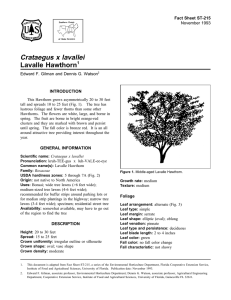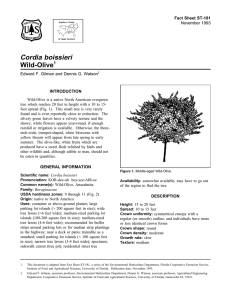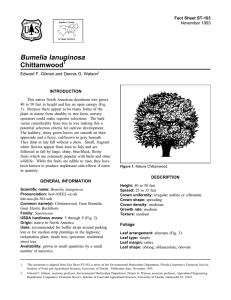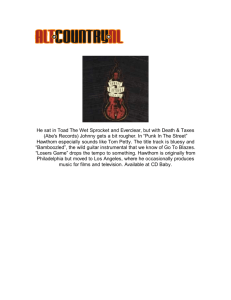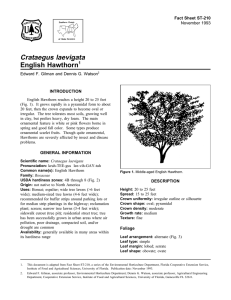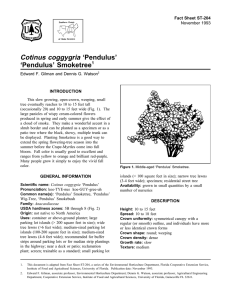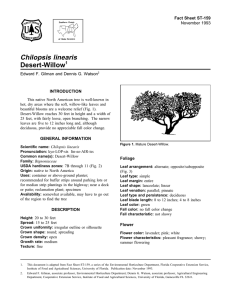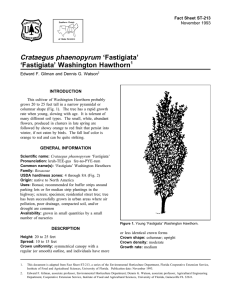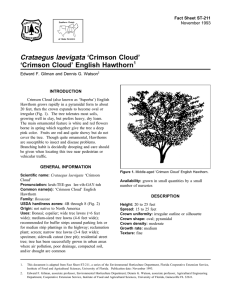Crataegus aestivalis May Hawthorn Fact Sheet ST-209 1
advertisement
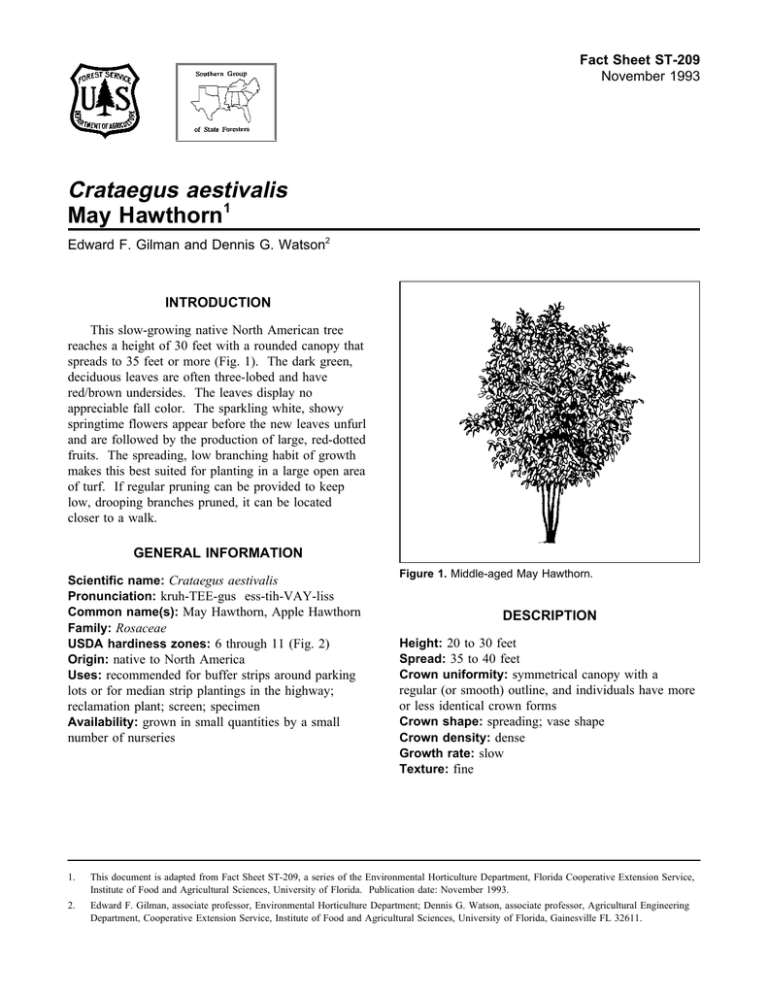
Fact Sheet ST-209 November 1993 Crataegus aestivalis May Hawthorn1 Edward F. Gilman and Dennis G. Watson2 INTRODUCTION This slow-growing native North American tree reaches a height of 30 feet with a rounded canopy that spreads to 35 feet or more (Fig. 1). The dark green, deciduous leaves are often three-lobed and have red/brown undersides. The leaves display no appreciable fall color. The sparkling white, showy springtime flowers appear before the new leaves unfurl and are followed by the production of large, red-dotted fruits. The spreading, low branching habit of growth makes this best suited for planting in a large open area of turf. If regular pruning can be provided to keep low, drooping branches pruned, it can be located closer to a walk. GENERAL INFORMATION Scientific name: Crataegus aestivalis Pronunciation: kruh-TEE-gus ess-tih-VAY-liss Common name(s): May Hawthorn, Apple Hawthorn Family: Rosaceae USDA hardiness zones: 6 through 11 (Fig. 2) Origin: native to North America Uses: recommended for buffer strips around parking lots or for median strip plantings in the highway; reclamation plant; screen; specimen Availability: grown in small quantities by a small number of nurseries Figure 1. Middle-aged May Hawthorn. DESCRIPTION Height: 20 to 30 feet Spread: 35 to 40 feet Crown uniformity: symmetrical canopy with a regular (or smooth) outline, and individuals have more or less identical crown forms Crown shape: spreading; vase shape Crown density: dense Growth rate: slow Texture: fine 1. This document is adapted from Fact Sheet ST-209, a series of the Environmental Horticulture Department, Florida Cooperative Extension Service, Institute of Food and Agricultural Sciences, University of Florida. Publication date: November 1993. 2. Edward F. Gilman, associate professor, Environmental Horticulture Department; Dennis G. Watson, associate professor, Agricultural Engineering Department, Cooperative Extension Service, Institute of Food and Agricultural Sciences, University of Florida, Gainesville FL 32611. Crataegus aestivalis -- May Hawthorn Page 2 Figure 2. Shaded area represents potential planting range. Foliage problem Leaf arrangement: alternate (Fig. 3) Leaf type: simple Leaf margin: crenate; serrate Leaf shape: elliptic (oval); obovate Leaf venation: pinnate Leaf type and persistence: deciduous Leaf blade length: 2 to 4 inches; less than 2 inches Leaf color: green Fall color: no fall color change Fall characteristic: not showy Trunk and Branches Trunk/bark/branches: droop as the tree grows, and will require pruning for vehicular or pedestrian clearance beneath the canopy; not particularly showy; should be grown with a single leader; no thorns Pruning requirement: requires pruning to develop strong structure Breakage: resistant Current year twig color: brown Current year twig thickness: medium; thin Flower Flower color: white Flower characteristics: showy; spring flowering Fruit Fruit Fruit Fruit Fruit Fruit shape: round length: .5 to 1 inch covering: fleshy color: red characteristics: does not attract wildlife; inconspicuous and not showy; no significant litter Culture Light requirement: tree grows in part shade/part sun; tree grows in full sun Soil tolerances: clay; loam; sand; slightly alkaline; acidic; well-drained Drought tolerance: moderate Soil salt tolerance: poor Crataegus aestivalis -- May Hawthorn Figure 3. Foliage of May Hawthorn. Other Roots: surface roots are usually not a problem Winter interest: no special winter interest Outstanding tree: not particularly outstanding Invasive potential: little, if any, potential at this time Verticillium wilt susceptibility: not known to be susceptible Pest resistance: long-term health usually not affected by pests USE AND MANAGEMENT May Hawthorn should be grown in full sun or partial shade on well-drained, moist soils. According to Dr. J. C. Raulston at North Carolina State University, this may be one of the best Hawthorns for the south due to superior disease resistance. Page 3
